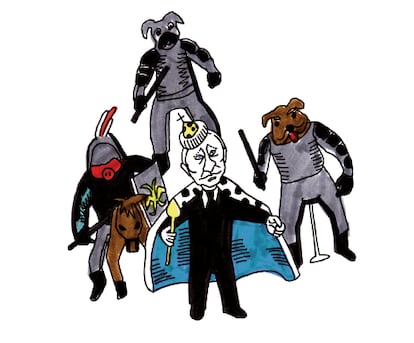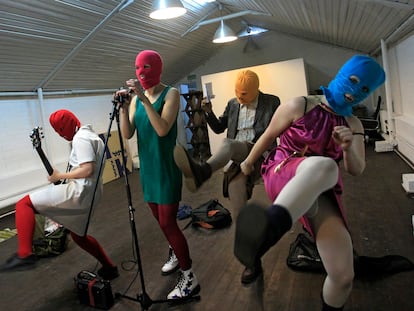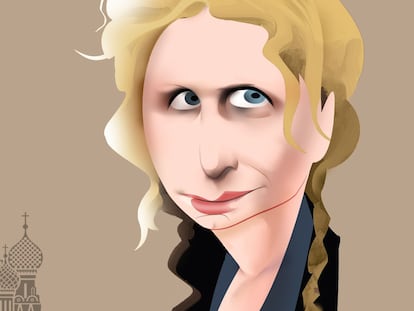Victoria Lomasko, exiled Russian artist: ‘In the 21st century, street protest has become a decorative act’
The author of ‘The Last Soviet Artist,’ a graphic journey of the many former republics that made up the giant that was the Soviet Union, talks about Alexei Navalny’s death and the role of a social artist

Victoria Lomasko is a Russian graphic artist whose work focuses on graphic reportage, a genre somewhere between the travelogue and journalism. After an exchange of messages, the interview takes place over email. The death of Russian dissident Alexei Navalny has just made headlines, and the email back-and-forth becomes a fluid conversation. Navalny in fact is the indirect protagonist of some of the stories she tells in her fascinating book The Last Soviet Artist, a graphic journey through the many of the former republics that made up the giant that was the Soviet Union and which has now been published in Spanish. Lomasko has been living in exile in Berlin since 2022.
Question. How has the news of Navalny’s death affected you?
Answer. When Navalny was alive, many people believed that it’s possible to return to their past and even return to Russia. Now it’s absolutely clear that we will never return to a life that is similar to our life before the war [in Ukraine]. It will be something new, very new, not similar to our plans and ideas, we cannot imagine this future anymore. It’s similar to how in 1917 people ran from Soviet Russia but continued to check the news and hoped to return. Then some events happened that showed it’s not Russia anymore, it’s USSR, another reality.
Q. Navalny said that people’s inaction is “the triumph of evil.” In your book, you also said that ignoring the authorities can be a way of pushing towards its end. What path do you think the Russian people will take after what has happened?
A. A popular answer to such a question is: “Go to the streets and protest!” I have a different opinion; I think that in the 21st century, street protest has become a decorative act. It is a peaceful theatrical show that allows the crowd to let off steam. Later, the crowd will get tired or dispersed by police. Everything is under the control of the authorities from the beginning. I say this as a participant of the large Moscow protests that lasted during all 2012, and as a participant of the peaceful Belarusian Revolution in 2022. In Belarus, probably 80% of the citizens protested, people there were beaten, raped, tortured, and dozens of protesters were killed. Now I live in Berlin, where all kinds of rallies are taking place. People are not being dispersed, but I don’t see the results of these rallies.
Q. What can be done, then?
A. I think it is better right now to do what you find useful and helpful. For example, even in Putin’s Russia there are people who donate to political prisoners, help Ukrainian refugees, develop underground culture, in a word: they create an independent universe which doesn’t cross into the universe of Putin’s regime. This is how the USSR collapsed, without any revolutions — just nobody believed in communist ideas, everyone lived in a parallel world with other ideas, dreams and goals.

Q. In your book, a Russian artist living in exile in Tbilisi, Georgia, describes what is happening in his country as “total madness.” In that context, what hope is possible from the point of view of art?
A. In my opinion, the goal of art is not to force to create revolutions but to help the evolution of everyone, a personal transformation. Politicians speak to crowds, but artists, writers, poets, filmmakers conduct a dialogue with you personally. Everyone is bigger than his or her social role. The goal of art is to help us never forget our greatness.
Q. Has the war in Ukraine led to a return to the conception of the Soviet Union that you grew up with?
A. As I said, the Soviet Union collapsed because most people no longer believed in communist ideas. Thirty-three years after the collapse of the Soviet Union, it is even more impossible to return to these ideas. I see the war in Ukraine as a renewal of a clear confrontation between countries like Russia, China, Iran and the collective West. I am sure the politicians know well why they are dividing the world into political blocs again. The question is to what extent we, ordinary people, are ready to get involved in their games.
Q. What is the relationship between the “social artist” and journalism?
A. A social artist, like a journalist, explores society and often gathers information in the field. The most important qualities for a good journalist are an interest in people and the skill to communicate with them. A good social artist must have these qualities as well.
Q. The characters in your book spark empathy that facilitates the acceptance of difference.
A. One of the goals of my book The Last Soviet Artist is to show how diverse the so-called Post-Soviet Space is. In the past, all these countries were Soviet republics, but now each one of them has its own way. And inside each country there are many uncrossable worlds. For instance, in Kyrgyzstan you can see in the street religious women in black hijabs but at the same time in Kyrgyzstan there are many feminist groups whose members can wear shorts, shave their heads, speak perfect English and travel across the world.

Q. I don’t want to sound pessimistic, but do you think there is hope for trusting the human race?
A. I think, if we compare our generations with generations of 20th century, we have become more conscious, agile and independent. For example, despite all Putin’s propaganda, there are practically no people in Russia willing to voluntarily participate in his war. Another example: during 2022-23, the Western media broadcasted non-stop Russophobia, cancelling Russian culture but at the same time dozens of Europeans who had other opinions were helping me to survive and show my art. And now, watching the tragedy in Gaza, many people feel disgusted at the cynicism of politicians who divide people into important and not important nations. I hope to see the time when the idea about good and bad nations will be just ridiculous and humanity will feel as one.
Sign up for our weekly newsletter to get more English-language news coverage from EL PAÍS USA Edition
Tu suscripción se está usando en otro dispositivo
¿Quieres añadir otro usuario a tu suscripción?
Si continúas leyendo en este dispositivo, no se podrá leer en el otro.
FlechaTu suscripción se está usando en otro dispositivo y solo puedes acceder a EL PAÍS desde un dispositivo a la vez.
Si quieres compartir tu cuenta, cambia tu suscripción a la modalidad Premium, así podrás añadir otro usuario. Cada uno accederá con su propia cuenta de email, lo que os permitirá personalizar vuestra experiencia en EL PAÍS.
¿Tienes una suscripción de empresa? Accede aquí para contratar más cuentas.
En el caso de no saber quién está usando tu cuenta, te recomendamos cambiar tu contraseña aquí.
Si decides continuar compartiendo tu cuenta, este mensaje se mostrará en tu dispositivo y en el de la otra persona que está usando tu cuenta de forma indefinida, afectando a tu experiencia de lectura. Puedes consultar aquí los términos y condiciones de la suscripción digital.
More information
Archived In
Últimas noticias
Most viewed
- Alain Aspect, Nobel laureate in physics: ‘Einstein was so smart that he would have had to recognize quantum entanglement’
- Maps of the US attack on Venezuela: Targets, airspace and deployed fleet
- Key points of the military attack on Venezuela: Early morning bombings and a ‘captured’ president
- David King, chemist: ‘There are scientists studying how to cool the planet; nobody should stop these experiments from happening’
- Oil, gold and rare earth elements: the backdrop to US political tension with Venezuela










































